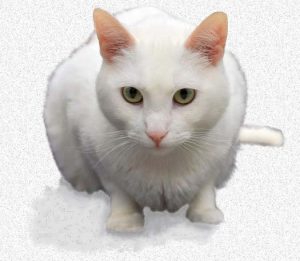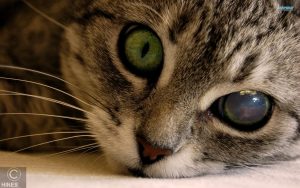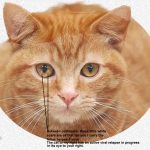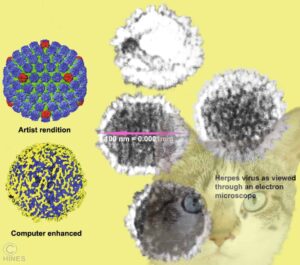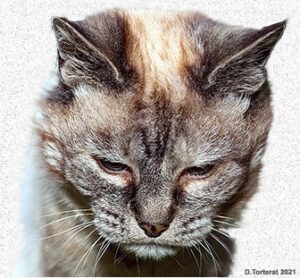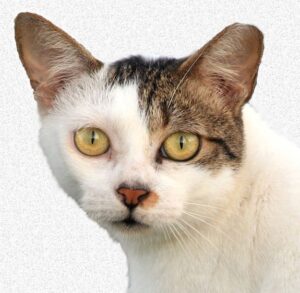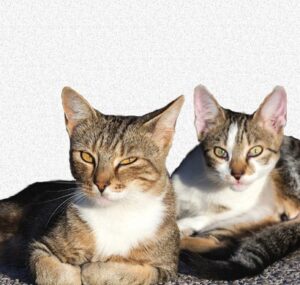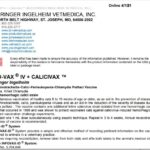Respiratory Disease In Your Cat And Kitten
Rhinotracheitis Virus Cat Flu or Herpes-1, Calicivirus, Chlamydia, Mycoplasma, and Bordetella
Ron Hines DVM PhD
You Might Also Find These Articles Helpful:


It is very common for cat owners to acquire a new kitten or cat that arrives with a crusty nose, weepy eyes or a sneeze. Or for those symptoms to develop soon after arrival. Veterinarians call these problems upper respiratory diseases (=URIs) because in the majority of cases, your cat’s lungs are not effected – just its nose, sinuses, pharynx, and eyes. It is rare for its lower trachea and lungs to be effected. Others refer to the problem as feline respiratory disease complex because it is common for more than one type of infectious organism to be responsible. These feline URIs are one of the most common problems veterinarians deal with.
Like the colds we suffer from, cat URI problems that develop in recent arrivals usually resolve – with or without treatment – in a week or two in their new, lower stress homes. But a few cases linger. There are several organisms that have the ability to cause this disease:
What Are The Causes Of Upper Respiratory Infections In Cats?
The most common cause by far is the Feline Herpes 1 virus (aka FeHV-1, cat flu virus, rhinotracheitis virus, gripa felina, katzengrippe, etc.). Just the fact that it goes by so many names gives you an indication of how common it is. This cat virus has a cousin that affects only dogs. (read here) Much more distant herpes relatives affect people. (read here) The herpes-1 cat virus is passed from cat to cat, most commonly through a sneeze. This virus is relatively fragile compared to other cat viruses. So, it rarely lives long enough outside of a cat to contaminate objects or the cat’s living premises. In a new, previously unexposed cat, the virus quickly (~24-48 hours) multiplies within the cells lining the new cat’s nose and upper airways (its respiratory epithelium). Often, the cell-covering surrounding your cat’s eyes (its conjunctiva) are also affected. The feline and similar herpes virus prefer those locations because the passage of room and outside air keep those areas slightly cooler than a cat’s inner core body temperature. (read here) Although the virus persists indefinitely within your cat’s body, these initial infection signs frequently last 1–3 weeks in otherwise healthy cats. Feline Herpes-1 cases are often more severe when other respiratory disease producing pathogens are also present. Those more complicated cases occasionally leave your cat with epithelial cell lining defects and lingering infections within their fragile nasal bones. That is the most common cause of chronic relapsing rhinitis and sinusitis in young adult cats. It is extremely difficult for your veterinarian to permanently cure these nasal bone infections. In older cats, a variety of potential nasal tumors complicate the diagnosis. (read here) Other cats are just left with a chronic conjunctivitis that tends to come and go with stress. Still others with corneal ulcers that refuse to heal (indolent ulcers). When they do heal, white scars are left. (read here) Between episodes, the virus silently dwells in the nerve ganglia of your cat’s face. Most scientists believe that once infected, a cat is never entirely free of the herpes virus. The virus is just dormant – sleeping for a while, or forever. Which cats will never show symptoms again, which will relapse under stress and which will develop chronic eye and nose problems is unpredictable. During relapses, your cat can again spread the virus to other cats. It cannot spread it to you. Corticosteroid medications such as prednisolone have also been known to reactivate dormant feline herpes virus. In one study, 70% of cats that changed households showed evidence that the stress of the move had caused them to resume shedding the feline herpes-1 virus. In another study, 18% percent of mother cats nursing kittens became virus-shedding positive. These queens (mother cats) have protective antibodies against herpes in their milk. Through their milk, they pass those protective antibodies on to their kittens. But in the stressful situations in which most cats reproduce, that maternal antibody level is often insufficient to keep the virus dormant in their kittens. Animal shelters face this issue every day of the year. There is frequently a lag time of a week or so between the time your cat undergoes a stress and the time it begins to show signs of a herpes relapse. House cats are not by nature a social species. Even something as trivial as a strange cat present in your yard and seen by your cat day-after-day through your living room window is very stressful to a territorial pet. Nasal and ocular discharges during relapses begin as water-like (serous). But with time they tend to become thick and sticky (=mucopurulent). (read here)
What Are The Rest Of The Organisms That Make The Problem Worse?
The second most common respiratory disease organism is probably Calicivirus. Some might even elevate its rank to first.
Unlike the herpes virus of cats, the feline calicivirus has many mutations that vary greatly in their virulence (their ability to do harm). One study identified 46 feline calicivirus strains (read here) Like the herpes virus, feline calicivirus has a fondness for the cat’s upper respiratory tract. But unlike the herpes virus, there are highly virulent strains of calicivirus that break out of the upper respiratory tract, and via the cat’s general circulation invade other parts of the body. A common location of that damage is in the area of the ears and paw pads. In other cases, the virus reaches the lungs, causing pneumonia. In still others, the liver and or pancreas is affected, producing jaundice, hemorrhage, vomiting, diarrhea and dehydration. (read here & here) Many severe cases are accompanied by mouth ulcers and a fetid breath (aka lymphoplasmacytic gingivitis stomatitis complex). These cases can be fatal. (read here) Most cats, however, recover and the virus can no longer be found in their upper respiratory tract or mouth a month later. However, a number of cats go on to be chronic carriers and potential spreaders of coronavirus. Some theorize that there could even be life-long carrier cats – although that has never been proven. In feral cat colonies, it can be assumed that coronavirus is always present. (read here & here)
Chlamydia felis
Chlamydia felis (aka Chlamydophila felis) is a bacteria. Unlike ordinary bacteria, chlamydia is small enough to live within cells of the body, not between them. They are as small or smaller than many viruses. (ask me for Donnett2014) That gives them advantages in avoiding your cat’s immune system. On rare occasions, the organism has been passed from cats to humans (conjunctivitis). (read here) This organism is very fragile. Because it does not survive for long outside of the cat, it passes from cat to cat primarily through close contact and mutual grooming – not through air systems or contaminated objects. There is very little known regarding the ability of Chlamydia felis to cause disease on its own. But it has been isolated from about 30% of cats that are experience chronic conjunctivitis. Cats in multi-cat households, purebred cats and cats under one year of age appear to be at higher risk of being positive for ocular chlamydia. The incubation period before conjunctivitis appears is thought to be 2–5 days. It may start out as squinting and lacrimation (excess tears) in one eye. But with time it is almost certain to spreads to the other eye. The cat’s “third eyelid”, its nictitating membrane, usually extends to cover the nasal-most portion of the eye in reaction to the inflammation the virus produces. (read here) In severe cases, the consistency of the tear material might thicken. Cats with a chlamydia eye infecting generally remain bright, cheerful and continue to eat. The organism typically limits its presence to your cat’s eyes and does not involve its nose or mouth. There have been a few cases where corneal ulcers and inflammation led to permanent blindness. But those cases were probably due to the cat rubbing its itchy eyes.
Mycoplasma and Bordetella organisms comprise the rest.
Mycoplasma felis aka M. haemofelis was traditionally called Haemobartonella felis. This organism, like chlamydia, is quite small. Fleas are thought to be the primary way these parasites transfer from one cat to another. Some strains have a preference for your cat’s red blood cells. Those strains result in anemia (haemotrophic mycoplasma). The disease produced is called feline infectious anemia or FIA. Research scientists are always keen to discover new pathogens, to have the privilege of naming them and a new scientific publication added to their resume list. So, there is constant bickering and name changing regarding cat mycoplasmas: M. haemofelis, M. haemominutum, and M. turicensis and hemoplasmas are some of the names that have been suggested. I would not pay much attention to these debates since they have nothing to do with how the disease they produce is treated.
There is another group of feline mycoplasma that have an affinity for your cat’s upper respiratory tract and eyes. These the non-haemotrophic strains. Names proposed for them are M. arginini, M. arthriditis, M. canadense, M. canis, M. cynotis, M. feliminutum, M. felis, M. gatae, M. hyopharyngis, M. lipophilum, M. pulmonic and M. spumans. Don’t pay much attention to those names, either. Many are probably duplicates of the same organism, and others identification errors. Just remember that some mycoplasma of cats prefers living in your cat’s red blood cells, and others prefer its respiratory tract and eyes. That may have as much to do with your individual cat’s immune system as it does with the organism involved. Since respiratory tract mycoplasma can be found in the respiratory tracts of normal cats, it is really unclear if their presence there are really important. I would relegate them to opportunists that take advantage of cats that are already stressed by other health and environmental issues. (read here)
Bordetella bronchiseptica is another small bacteria that resides in the respiratory tract of many animal species, including cats. When it affects dogs, it is one of the organisms implicated in kennel cough. Bordetella infection is also a common upper respiratory problem in stressed, crowded pigs in the pork industry. It appears that this organism prefers to dwell in (colonize) areas that are slightly cooler than the animal’s deeper internal environment. Over the years, bordetella has become resistant to many antibiotics because of its ability to produce biofilms. (read here) Doxycycline is currently an antibiotic of choice in the treatment of bordetella. Doxycycline must never be given to cats in tablet form, unless it is crushed and followed by water. (read here) There have been a few recorded cases of Bordetella bronchiseptica infecting people. But those cases are quite rare and generally occur in people with suppressed immune systems (immunocompromized). Although Bordetella is usually spread from cat to cat by direct contact with nasal and oral secretions, that is not always the case. One study performed long ago found that the organism could survive up to 5 months in the environment when dry and at room temperature. It also found that bordetella was resistant to repeated freezing. (R.F.Ross1965) Mother cats pass their resistance to B. bronchiseptica on to their kitten through their colostrum. However, that maternal immunity subsides over the next 2–8 weeks. After that, kittens can present with (come down with) sneezing, eye discharges, coughing, and even breathing difficulties with bordetella (and probably other organisms) as the cause. These problems usually resolve over the next 7–12 days, but cats continue to spread the organism for considerably longer – perhaps indefinitely. (read here & here) Once utensils and the cat’s environment are cleaned with soapy water, ordinary household bleach rapidly kills bordetella.
Can I Tell Which Organisms Are Causing My Cat’s Problem From The Signs I See?
No.
Your vet can’t either, unless the tell-tail whitish corneal scars of a relapsing Herpes-1 infection are already present. (read here) And even then, multiple organisms could still be present. When cats first come down with these diseases, they often run a fever, sneeze and become listless. Their appetite may wane. After the first few days of illness, their body temperature returns to normal. A cat’s normal body temperature is 101.5-102.5 F (38.6-.39.2 C). Cats with first-time respiratory tract infections can reach 106 F (41.1 C) during their first few days of illness. That is why your cat’s adequate fluid intake is so important to prevent dehydration. Cats with calicivirus often drool due to ulcers on their tongue, lips, and the roof of the mouth. These cats rarely show signs of pneumonia because these organisms usually spare the lungs. Nasal drainage is often watery at first. With time, the discharges can become thick, tenacious, and mucoid. In cat’s with eye involvement their eyes often become reddened, inflamed and weepy. Signs can last a week or so in mild cases, but many months in stressed cats, frail cats and immunosuppressed cats that are positive for FLV or FIV. Mature and semi-mature cats almost never die from these upper respiratory tract infections. It is primarily life-threatening in weak, star crossed kittens that stop eating and are already in a weakened state.
What Are Some Things That Will Speed My Cat’s Recovery?
Although veterinarians, including myself, are likely to prescribe an oral antibiotic such as doxycycline for your cat (read here), viruses are not killed by antibiotics. Only when your cat’s problem includes chlamydia, mycoplasma or bordetella coinfections are antibiotics actually helpful. Veterinarians put these cats on antibiotics because we are never sure which pathogens are present, and to lessen the chances of secondary pneumonia and lingering chronic sinusitis in debilitated patients.
I have found that most cases of upper respiratory disease complex responds well to simple T.L.C. Boiled chicken, blended and served as soup or broth, is an excellent treatment for this disease. You can feed it through an eye dropper or spoon it if need be to prevent dehydration and to tempt your depressed cat into eating. Nasal involvement decreases a cat’s interest in eating, so pungent smelling foods such as sardines and tuna will often be accepted when other diets fail. I place these cats on a liquid multivitamin formula as well, because so many of them are only willing to eat unsupplemented meat or fish. Commercial nutricaloric pastes are a less desirable option. Cats that are severely congested might feel better when vaporizers, steam and nasal decongestants are used. Tetracycline or lubricating eye ointments ease eye inflammation and crusty, painful nostrils. Not too long ago, Elanco Pharmaceuticals introduced Elura™(capromorelin) as an appetite stimulant for cats. However, its unpleasant taste can present a challenge. (read here) Plump cats that won’t eat are subject to hepatic lipidosis.
Is There A More Specific Treatment When Feline Herpes-1, The Rhinotracheitis Virus, Is Involved?
Yes
The best medication veterinarians have to treat Feline Herpes-1 virus infections or its later flare-ups is famciclovir (Famvir®). Read about that medication here and here. This medication is bitter. In one of those studies, 40 mg/Kg, given three times a day for an average of 40 days, appeared to be as effective as 90 mg/Kg given at the same frequency. You might have more success purchasing a better tasting formula from an online custom veterinary pharmacy. Several claim to sell famciclovir in tasteless capsules, chew treats, an oral powder and in combination with doxycycline or azithromycin, in case bacterial organisms such as mycoplasma or bordetella are also involved in your cat’s health issue. To avoid the bitterness issue when your cat has a herpes eye problem, topical ganciclovir gel (Zirgan®), applied 3 times a day, appeared to be just as effective as oral famciclovir in reducing eye inflammation. (read here)
There was a time when veterinarians, including myself, thought that an amino acid, l-lysine, supplement might be helpful to some of these eye-related herpes cases in cats. That was based on the finding that consuming lysine appeared to be helpful for people with herpes sores. (read here) It was proposed that lysine reduced the amount of another amino acid, arginine, that herpes viruses required to multiply. However, more recent studies found that lysine did not have that therapeutic effect in cats and probably was ineffective in humans as well. (read here & here)
Herpes Carrier Cats
A small number of cats infected with this herpes virus (aka rhinotracheitis) will lapse into a chronic active state that lasts for years – or for a lifetime. They are subject to intermittent eye inflammations, and draining nostrils – usually brought on by stress. Others develop milky colored areas of their corneas that come and go. In their inactive states, these eye lesions are milky white, circular scars within the corneal layers. We call this disease herpetic keratitis. When rhinotracheitis flares up as corneal ulcers, many cats squint and tear as their outer eye membranes become inflamed. As I mentioned, these flare-ups are often associated with the stress of boarding, weather changes, other diseases or the arrival of new cats in the family. Read more about that problem here.
Are There Ways To Immunize My Cat Against Herpes 1 Viral Problems?
Sometimes
Effective vaccines are available to immunize cats against herpes 1/rhinotracheitis virus. See two commonly administered ones above. Many veterinarians administer these vaccines beginning when kittens are 8 or 9 weeks of age and again at 10 – 12 weeks of age, perhaps even a third time and then with periodic 1-3 year boosters. The problem is that many kittens are already infected with the Herpes 1 virus before their first vaccination. The stress of pregnancy and nursing causes many herpes-carrier mothers to relapse and pass the virus on to their kittens before their first kittenhood vaccination. You cannot close the barn door after the horse has left. Vaccines do not work retroactively. Many young cats from shelters are in the middle of a Herpes 1 infection when I first see them – often compounded by other pathogens. In those instances, the vaccine is not effective. Manufacturers still often suggest yearly revaccination with their products. Vaccination office calls low stress veterinary income (for everyone but the cat) and lucrative for the pharmaceutical companies that sell them. When I feel a cat truly needs vaccinations, I administer them through a 25-gauge needle in the anterior (front) side of a rear leg, or the cat’s tail. Then I gently massage the injection site to spread the injecta. That, perhaps, decreases the rare instances where tumors forms at vaccine injection sites. (read here) For unknown reasons, cats are considerably more prone to that than dogs or humans.
Within the last few years, veterinarians have been given a tremendous new tool for sorting out the various organisms that can cause respiratory problems in your cat. (read here) Sophisticated central veterinary laboratories throughout the United States, Europe, and the UK to do this. All utilize a very sensitive test, the Polymerase Chain Reaction or PCR test to look for six of the most common causes of upper respiratory and/or chronic eye problems in cats, bordetella, chlamydia, calicivirus, herpes 1 and mycoplasma. One limitation of these panels is that the most common cause of recurrent sneezing, the herpes-1/rhinotracheitis virus, is so stealthy that it can even avoid detection with the PCR test when the virus is dormant (sleeping) in nerve ganglia, a common place where it dwells between flare-ups. So if the PCR test is positive for herpes-1, your cat is definitely a carrier of the virus. But if the test is negative, it might still be sleeping somewhere deep within your cat. You might consider having the test repeated at a later date during a sneezing or conjunctivitis flare-up.
You are on the Vetspace animal health website
Visiting the products that you see displayed on this website help pay the cost of keeping these articles on the Internet.

